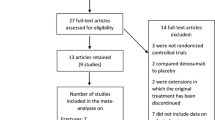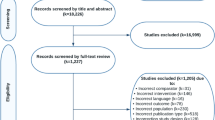Abstract
The National Institute for Health and Clinical Excellence (NICE) invited the manufacturer of denosumab (Amgen Inc., UK) to submit evidence for the clinical and cost effectiveness of denosumab for the prevention of fragility fractures in post-menopausal women, as part of the Institute’s single technology appraisal (STA) process. The University of Aberdeen Health Technology Assessment Group were commissioned to act as the Evidence Review Group (ERG); the role of the ERG being to appraise the manufacturer’s submission and to produce an independent report. This article provides a description of the company submission, the ERG review and NICE’s subsequent decisions.
The manufacturer considered that denosumab would be appropriate for patients unable to take, comply with or tolerate oral bisphosphonates.Comparator treatments selected for the submission were, therefore, ‘no treatment’, raloxifene, strontium ranelate, intravenous zoledronic acid, intravenous ibandronate and teriparatide. The main effectiveness evidence for denosumab was derived from a large randomized controlled trial comparing denosumab with placebo. Given by subcutaneous injection at 6-monthly intervals for 3 years, denosumab reduced the incidence of hip fracture by 40%, and reduced the incidence of clinical vertebral fracture by 69%. An indirect treatment comparisonwas used to derive adjusted relative risk (RR) estimates for different types of fracture for each comparator versus placebo. The RRs (95%CI) applied for denosumab were 0.316 (0.208, 0.478) for clinical vertebral fracture, 0.605 (0.373, 0.983) for hip fracture and 0.842 (0.638, 1.110) for wrist fracture. Despite a number of concerns surrounding the methodology of the indirect comparison, the ERG was satisfied with the robustness of the effect estimates.
The RR estimates were applied in a good-quality Markov model that took account of drug costs, administration and monitoring costs, costs associated with fractures, and long-term nursing home costs. Utility weights were used to adjust time spent in fracture states, allowing QALYs to be estimated. The base-case analysis was conducted for women aged 70 years with a T-score of -2.5 or less and no prior fracture, and women aged 70 years with a T-score of -2.5 or less with a prior fragility fracture. Subgroup analyses based on T-score and independent clinical risk factors were also undertaken.
Applying a willingness-to-pay (WTP) threshold of £30 000 per QALY, the manufacturer’s results suggested that denosumab would offer a cost-effective alternative to all treatment comparators for the primary and secondary prevention of fractures. The ERGwas concerned about an assumption that denosumab wouldbe administered in generalpractice at the average cost of two standard GP visits a year. As a result, the ERG requested some further sensitivity analysis and undertook some further modelling, applying an assumption that denosumab would be provided primarily in secondary care. This modification altered the cost effectiveness of denosumab versus ‘no treatment’ (in women with no prior fragility fracture) and zoledronic acid.
The NICE Appraisal Committee concluded that, as a treatment option for the prevention of osteoporotic fractures, denosumab should be recommended only in post-menopausal women at increased risk of fracture who cannot comply with the special instructions for administering oral bisphosphonates, or have an intolerance of, or contraindication to, those treatments. For primary prevention, the Appraisal Committee also stipulated specific levels of fracture risk at which denosumab is recommended.

Similar content being viewed by others
Notes
1 T-score measuresBMDusing central (hip and/or spine) dual-energy x-ray (DXA) scanning, and is expressed as the number of SDs below peak BMD.
References
National Institute for Health and Clinical Excellence. Guide to the single technology appraisal process. London: NICE, 2009 Oct [online]. Available from URL: http://www.nice.org.uk/media/913/06/Guide_to_the_STA-proof_6-26-10-09.pdf [Accessed 2010 Dec 3]
Sculpher M. Single technology appraisal at the UK National Institute for Health and Clinical Excellence: a source of evidence and analysis for decision making internationally. Pharmacoeconomics 2010; 28 (5): 347–9
Rodgers M, Griffin S, Paulden M, et al. Alitretinoin for severe chronic hand eczema: a NICE single technology appraisal. Pharmacoeconomics 2010; 28 (5): 351–62
Bagust A, Greenhalgh J, Boland A, et al. Cetuximab for recurrent and/or metastatic squamous cell carcinoma of the head and neck: a NICE single technology appraisal. Pharmacoeconomics 2010; 28 (6): 439–48
Stevenson M, Pandor A. Febuxostat for the management of hyperuricaemia in patients with gout: a NICE single technology appraisal. Pharmacoeconomics 2011; 29 (2): 133–40
Dickson R, Bagust A, Boland A, et al. Erlotinib monotherapy for the maintenance treatment of non-small cell lung cancer after previous platinum-containing chemotherapy: a NICE single technology appraisal. Pharmacoeconomics. In press
McKenna C, Maund E, Sarowar M, et al. Dronedarone for the treatment of atrial fibrillation: a NICE single technology appraisal. Pharmacoeconomics. In press
Holmes M, Carroll C, Papaioannou D. Dabigatran etexilate for the prevention of venous thromboembolism in patients undergoing elective hip and knee surgery: a NICE single technology appraisal. Pharmacoeconomics. In press
Boyers D, Jia X, Jenkinson D, et al. Eltrombopag for the treatment of chronic idiopathic (immune) thrombocytopenic purpura (ITP): a NICE single technology appraisal. Pharmacoeconomics. In press
National Institute for Health and Clinical Excellence. Osteoporotic fractures: denosumab. London: NICE [online]. Available from URL: http://guidance.nice.org.uk/TA/Wave20/75 [Accessed 2011 Jul 4]
National Institute for Health and Clinical Excellence. Alendronate, etidronate, risedronate, raloxifene and strontium ranelate for the primary prevention of osteoporotic fragility fractures in postmenopausal women. London: NICE, 2010 Jan [online]. Available from URL: http://www.nice.org.uk/TA160 [Accessed 2010 Dec 3]
European Medicines Agency. Prolia: denosumab. European Public Assessment Report (EPAR). London: EMA, 2010 [online]. Available from URL: http://www.ema.europa.eu/ema/index.jsp?curl=pages/medicines/human/medicines/001120/human_med_001324.jsp&murl=menus/medicines/medicines.jsp&mid=WC0b01ac058001d124&jsenabled=true [Accessed 2010 Dec 3]
National Institute for Health and Clinical Excellence. Single technology appraisal (STA): denosumab for the prevention of osteoporotic fractures in post-menopausal women. Manufacturer/sponsor submission of evidence, Amgen UK Ltd. Submitted 22 January 2010, resubmitted 15 February 2010. London: NICE, 2010 Feb [online]. Available from URL: http://www.nice.org.uk/nicemedia/live/12174/49288/49288.pdf [Accessed 2010 Dec 3]
Scotland G, Royle P, Henderson R, et al. Evidence review: denosumab for the prevention of osteoporotic fractures in post-menopausal women. Aberdeen HTA Group, 2010 [online]. Available from URL: http://www.nice.org.uk/nicemedia/live/12174/49283/49283.pdf [Accessed 2011 Jul 4]
National Institute for Health and Clinical Excellence. Systematic reviews of clinical effectiveness prepared for the guideline ‘Osteoporosis: assessment of fracture risk and the prevention of osteoporotic fractures in individuals at high risk’. London: National Collaborating Centre for Nursing and Supportive Care, 2008 Sep [online]. Available from URL: http://www.nice.org.uk/guidance/index.jsp?action=folder&o=42361 [Accessed 2010 Dec 3]
National Institute for Health and Clinical Excellence. Osteoporosis guideline. London: NICE [in development; online]. Available from URL: http://guidance.nice.org.uk/CG/Wave7/32 [Accessed 2010 Dec 3]
Cummings SR, San MJ, McClung MR, et al. Denosumab for prevention of fractures in postmenopausal women with osteoporosis. N Engl J Med 2009; 361 (8): 756–65
Bucher HC, Guyatt GH, Griffith LE, et al. The results of direct and indirect treatment comparisons in meta-analysis of randomized controlled trials. J Clin Epidemiol 1997; 50 (6): 683–91
US FDA. Background document for meeting of Advisory Committee for Reproductive Health Drugs (August 13, 2009). Denosumab (proposed trade name: PROLIA): Amgen, Inc. Silver Spring (MD): US FDA, 2009 Aug [online]. Available from URL: http://www.fda.gov/downloads/AdvisoryCommittees/CommitteesMeetingMaterials/Drugs/ReproductiveHealthDrugsAdvisoryCommittee/UCM176605.pdf [Accessed 2010 Dec 3]
Strom O, Macarios D, Badamgarav E, et al. Costeffectiveness model for denosumab incorporating FRAX® and adherence in a UK setting [abstract]. Osteoporos Int 2009; 20 Suppl. 1: 20
Hiligsmann M, Reginster JY. Cost-utility of denosumab for the treatment of postmenopausal osteoporotic women [abstract]. Osteoporos Int 2009; 20 Suppl. 1: 16
Kanis JA, Johnell O, Oden A, et al. FRAX and the assessment of fracture probability in men and women from the UK. Osteoporos Int 2008; 19 (4): 385–97
National Institute for Health and Clinical Excellence. Osteoporosis: secondary prevention including strontium ranelate. Alendronate, etidronate, risedronate, raloxifene, strontium ranelate and teriparatide for the secondary prevention of osteoporotic fragility fractures in postmenopausal women. London: NICE, 2010 [online]. Available from URL: http://www.nice.org.uk/TA161 [Accessed 2010Dec 3]
National Institute for Health and Clinical Excellence. Denosumab for the prevention of osteoporotic fractures in postmenopausal women: appraisal consultation document. London: NICE, 2010 [online]. Available from URL: http://guidance.nice.org.uk/TA/Wave20/75/Consultation/DraftNICEGuidance [Accessed 2010 Dec 3]
Reginster JY, Seeman E, De Vernejoul MC, et al. Strontium ranelate reduces the risk of non-vertebral fractures in postmenopausal women with osteoporosis: Treatment of Peripheral Osteoporosis (TROPOS) study. J Clin Endocrinol Metab 2005; 90: 2816–22
Reginster JY, Felsenberg D, Boonen S, et al. Effects of longterm strontium ranelate treatment on the risk of nonvertebral and vertebral fractures in postmenopausal osteoporosis: results of a five-year, randomized, placebocontrolled trial. Arthritis Rheum 2008; 58 (6): 1687–95
Black D, Eastell R, Cosman F, et al. Efficacy of once-yearly zoledronic acid 5mg on a sub-set of six non-vertebral fractures [poster no. 360]. 31st Annual Meeting of the American Society for Bone and Mineral Research; 2009 Sep 11–15; Denver (CO) [online]. Available from URL: http://www.asbmr.org/Meetings/AnnualMeeting/AbstractDetail.aspx?aid=f6a118a8-e20f-45a3-a03f-d7083bc551ca [Accessed 2010 Dec 3]
National Institute for Health and Clinical Excellence. Osteoporotic fractures: denosumab. Final appraisal determination. London: NICE, 2010 Sep [online]. Available from URL: http://guidance.nice.org.uk/TA/Wave20/75/FAD [Accessed 2010 Dec 3]
Acknowledgements
This project was funded by the National Institute for Health Research Health Technology Assessment Programme (project number 08/231). This summary of the ERG report was compiled after the Appraisal Committee’s review. This summary has not been externally peer reviewed by PharmacoEconomics.
The views and opinions expressed therein are those of the authors and do not necessarily reflect those of the Department of Health. Two of the authors (RH and RH) are NHS employees. The NHS has a financial interest in the guidance issued by NICE as a result of this project. NW and PR are now employed by Warwick Evidence, Warwick Medical School, Coventry, England.
Author information
Authors and Affiliations
Corresponding author
Rights and permissions
About this article
Cite this article
Scotland, G., Waugh, N., Royle, P. et al. Denosumab for the Prevention of Osteoporotic Fractures in Post-Menopausal Women. Pharmacoeconomics 29, 951–961 (2011). https://doi.org/10.2165/11589310-000000000-00000
Published:
Issue Date:
DOI: https://doi.org/10.2165/11589310-000000000-00000




